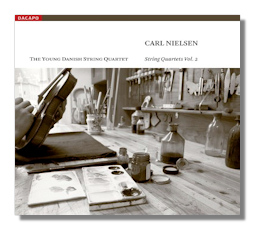
The Internet's Premier Classical Music Source
Related Links
- Nielsen Reviews
- Latest Reviews
- More Reviews
-
By Composer
-
Collections
DVD & Blu-ray
Books
Concert Reviews
Articles/Interviews
Software
Audio
Search Amazon
Recommended Links
Site News
 SACD Review
SACD Review
Carl Nielsen

String Quartets, Volume 2
- String Quartet #2 in F minor, Op. 5 (1890) [34:17]
- String Quartet #3 in E Flat Major, Op. 14 (1898) [29:42]
The Young Danish String Quartet
Recorded at the Danish Radio Concert Hall, Copenhagen, June/August 2007
Released May 2008
Dacapo 6.220522 Hybrid Multichannel SACD 63:59
Comparisons:
Danish Quartet/Kontrapunkt 32150 (rec. 1993)
Kontra Quartet/BIS CD-503 (rec. 1990)
Kubin Quartet/Centaur CRC2325 (rec. 1996 –, Op. 5 only)
Oslo Quartet/Naxos 8.553907 & 8.553908 (rec. 1997/98)
Vertavo Quartet/Simax PSC1128 (rec. 1995 –, Op. 5 only)
Zapolski Quartet/Chandos CHAN9817 (rec. 1996/99)
With Volume 2, The Young Danish String Quartet completes its excellent traversal of the four numbered Carl Nielsen (1865-1931) string quartets. These are early Nielsen works except for the Quartet #4 in F Major composed in 1919. Still, we find in this music a bridge between the traditions of the Romantic era and the early 20th Century aesthetic. Nielsen graces us with an abundance of harmonic adventure and delicious moments of key ambiguity as he searches for a home key such as in the opening bars of the E Flat Major Quartet's 2nd Movement "Andante Sostenuto". Another impressive feature of the String Quartets is the wide array of emotional content ranging from the fierce and rugged first theme of the F minor Quartet to the E Flat Major Quartet's sublime and gorgeous lyricism of the 1st Movement. My interpretive preferences for these works tend toward forward-looking performances of a rustic nature that that neither stint on the composer's rugged terrains nor his more tender and heart-felt declarations.
Although Nielsen's String Quartets are not among his more popular works, they are very strongly represented on record. Each of the comparison versions are worthy contenders with the Danish, Kubin, Oslo and Vertavo Quartets heading the list. The Zapolski Quartet's interpretations are quite interesting and romantic, although I should caution that the group takes many liberties with the scores. Concerning the highly praised recordings by the Kontra Quartet, I have a few reservations: the performances minimize the effect of the music's harmonic experimentation, are rather cosmopolitan and recorded in an overly reverberant acoustical setting. This "wet" sound stage is damaging to the composer's counterpoint fugal passages such as the two fugues of the E Flat Major Quartet's 4th Movement.
The Young Danish String Quartet was formed in 2001 when each member was under 18 years of age. The group studied under Professor Tim Frederiksen at the Royal Danish Academy of Music and was the youngest ensemble to win the Dr. Chamber Music Competition. It has subsequently won many other prestigious competitions and has concertized in Germany, Holland, Scandinavia and the United States.
Although only young adults, the group members show a remarkable affinity for the Nielsen idiom, entirely up to the highest standards achieved by the comparison recordings. Their youthful exuberance is second to none while they also convey the full measure of poignancy and expression in the slower movements and passages. Further, they are compelling in their blending of the composer's romantic foundations with his daring harmonic progressions.
Among the numerous highlights of the performances, a few features stand out in my mind. In the Quartet in F minor, the group treats the opening theme as an apocalyptic event, and the 3rd Movement is irresistible with its playful and boldly projected phrasing. Concerning the Quartet in E Flat Major, the ensemble offers the maximum degree of mystery to the 2nd Movement's central section dominated by dotted rhythms, the 3rd Movement's central section is played in a wild and intense manner and the fugal elements of the 4th Movement are beautifully detailed and infectious.
In addition to the exceptional performances, The Young Danish String Quartet has a sonic advantage over the competition. In glorious SACD sound, the acoustics are fantastic in expansiveness, depth and clarity, resulting in an illumination of each musical strand. As fine as the sound stage is for most of the comparison versions, they simply can't match a superbly engineered SACD recording.
Don's Conclusions: Given the high quality of performances and superlative sound offered by Dacapo, The Young Danish String Quartet's traversal of the Nielsen String Quartets is now the most desirable on the market. For those on a tight budget, the set by the Oslo Quartet on Naxos represents a fine alternative.
Copyright © 2009, Don Satz




















